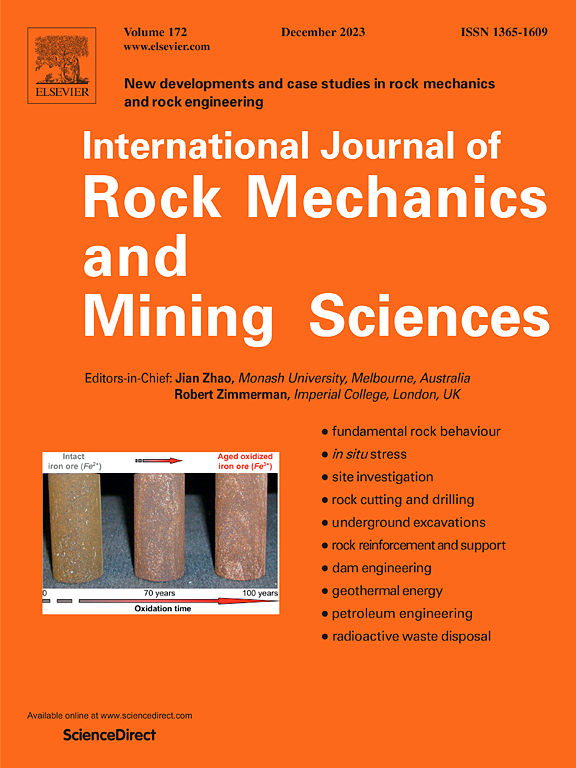成熟砂岩储层中弹性波诱导流体流动的位移-压力耦合模型
IF 7
1区 工程技术
Q1 ENGINEERING, GEOLOGICAL
International Journal of Rock Mechanics and Mining Sciences
Pub Date : 2024-10-18
DOI:10.1016/j.ijrmms.2024.105928
引用次数: 0
摘要
弹性(地震)波刺激被认为是非常规提高石油采收率(EOR)的方法之一。在成熟油藏的高渗透层中增加水量极具挑战性,而且由于油藏的异质性,最终采收率会显著降低。与传统的 EOR 方法相比,使用地震波可以说是低成本、环保的,而且可以照亮整个储层。通过扩展波诱导流体流动(WIFF)引起的地震衰减的 Quintal 方法,建立了一个数值模型,将部分饱和多孔介质中的毛细管压力纳入其中,并改变了排水边界条件,排除了排水边界条件中的外部流动应力。因此,毛细管效应导致的流体分布使得所开发的有限元法(FEM)u-p 模型更广泛地适用于成熟油藏的采油。对双层部分饱和介质施加低频(3 Hz)压缩地震应力。结果表明,无论是完全饱和还是部分饱和介质,底层和上层的垂直位移梯度都随着激励时间的延长而减小。另一方面,由于毛细管压力的影响,上层和底层的部分饱和孔隙压力梯度随激励时间的变化幅度比完全饱和孔隙压力梯度大。在 200 md、100 md 和 50 md 的低渗透层中,连续激励 180 天的累计横流油量分别为 1176 桶、1032 桶和 648 桶。因此,所开发的模型具有现场规模 EOR 应用的潜力。研究还建议将弹性 EOR 与二氧化碳淹没耦合,以在低渗透储层或致密地层中提高流体流动性和石油相对渗透性,从而开采出更多的石油。本文章由计算机程序翻译,如有差异,请以英文原文为准。
A coupled displacement-pressure model for elastic waves induce fluid flow in mature sandstone reservoirs
Elastic (seismic) wave stimulation is considered one of the unconventional enhanced oil recovery (EOR) methods. Increasing water quantity in the high permeability layer of a mature oil reservoir is highly challenging and can significantly decrease the ultimate recovery due to the reservoir heterogeneity. Using seismic waves can be considered low-cost, environmentally friendly, and illuminates the entire reservoir size compared to conventional EOR methods. A numerical model is developed by extending the Quintal approach for seismic attenuation due to wave-induced fluid flow (WIFF) to incorporate capillary pressure in partially saturated porous media and shift undrained boundary conditions to exclude external flow stress for drained boundary conditions. Therefore, the fluid distribution due to the capillary effect makes the developed finite element method (FEM) u-p model more widely applicable for oil recovery in mature reservoirs. A two-layer partially saturated media was subjected to compressive seismic stress at low frequency (3 Hz). The results indicated that the vertical displacement gradients of the bottom and upper layers decline with excitation time for both fully and partially saturated media. On the other hand, partially saturated pore pressure gradients of both the upper and bottom layers have higher amplitudes with excitation time than fully saturated pore pressure gradients due to the influence of capillar pressure. The cumulative crossflow oil volume for 180 days of continuous stimulation was 1176 bbl, 1032 bbl, and 648 bbl in low permeability layers: 200 md, 100 md, and 50 md, respectively. Therefore, the developed model has the potential for field-scale EOR applications. The study also suggests coupling elastic EOR with CO2 flooding to recover more oil due to increasing fluid mobility and relative permeability to oil in low-permeability reservoirs or tight formations.
求助全文
通过发布文献求助,成功后即可免费获取论文全文。
去求助
来源期刊
CiteScore
14.00
自引率
5.60%
发文量
196
审稿时长
18 weeks
期刊介绍:
The International Journal of Rock Mechanics and Mining Sciences focuses on original research, new developments, site measurements, and case studies within the fields of rock mechanics and rock engineering. Serving as an international platform, it showcases high-quality papers addressing rock mechanics and the application of its principles and techniques in mining and civil engineering projects situated on or within rock masses. These projects encompass a wide range, including slopes, open-pit mines, quarries, shafts, tunnels, caverns, underground mines, metro systems, dams, hydro-electric stations, geothermal energy, petroleum engineering, and radioactive waste disposal. The journal welcomes submissions on various topics, with particular interest in theoretical advancements, analytical and numerical methods, rock testing, site investigation, and case studies.

 求助内容:
求助内容: 应助结果提醒方式:
应助结果提醒方式:


